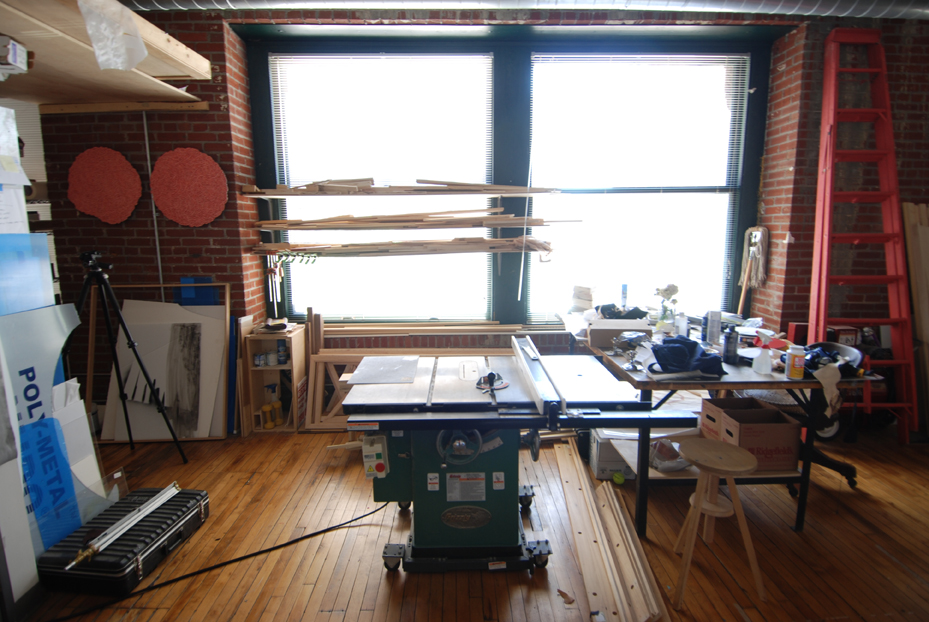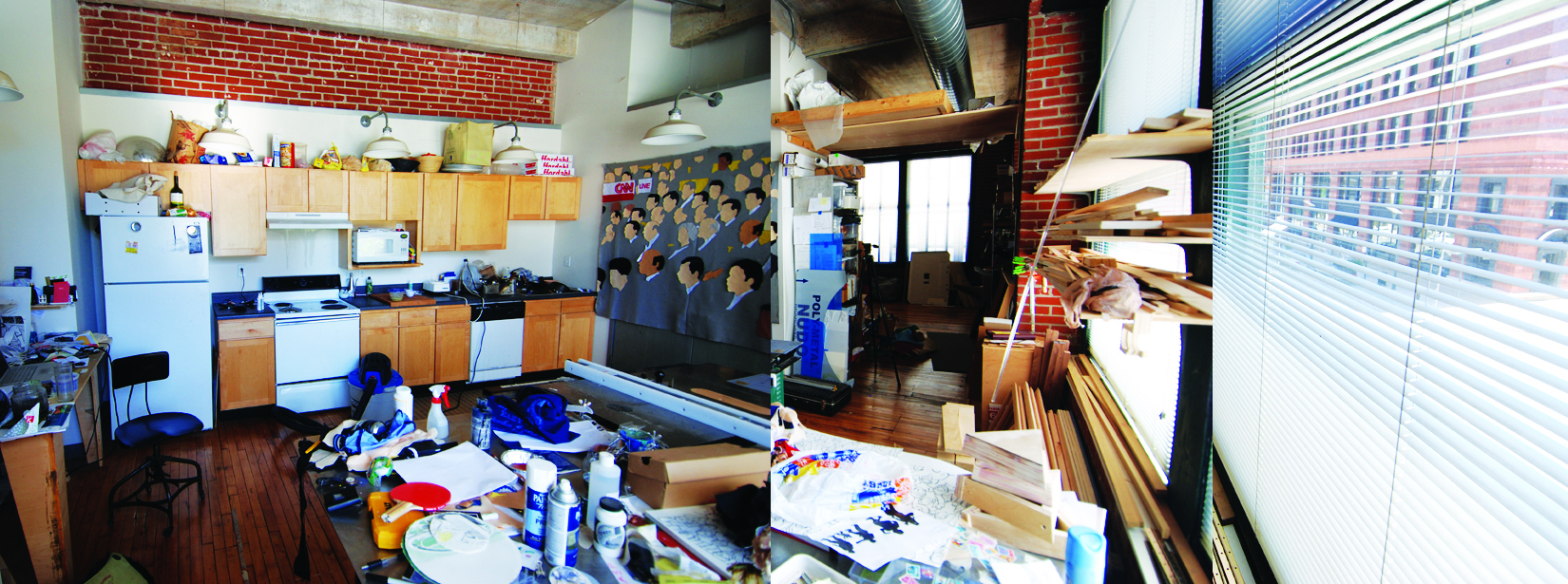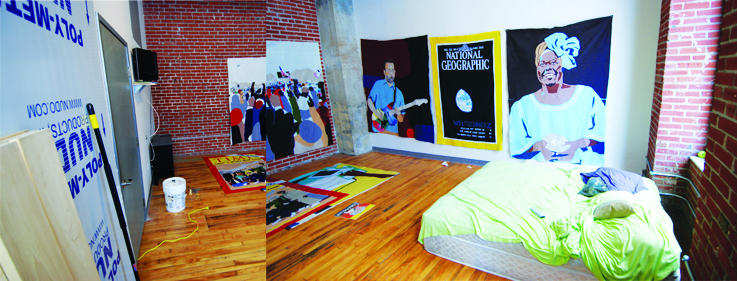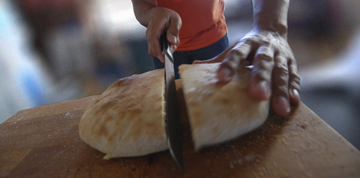
Corey Escoto at his studio
Corey Josiah Escoto is an artist based in St. Louis, MO. He also happens to be a tranquil, discreet, and steady 26 year-old art surprise who acts, talks, and walks like himself. Escoto is wisely pacing himself, revealing a few of his qualities at a time while continually giving me the impression he is learning, paying attention, and alert without letting it show.
Humble at heart, he has exhibited nationally, internationally, and widely throughout Texas, his home state. He was one of three artists selected for the Great Rivers Biennial at the Contemporary Art Museum St. Louis in 2008, where I first became acquainted with his work, as well as a recipient of the Gateway Foundation Grant. His work has been included in the traveling exhibition New American Talent 23, the Texas Biennial (2007), and has recently shown internationally in exhibitions such as Le Souvenir (Weimar, Germany); Seven Days Brunch (Basel, Switzerland); and Decollecting (Dunkerque, France).
Escoto’s work explores the inevitable conflict between idealism and futility that results from endeavoring to better a troubled world and understanding the tensions of a crowded planet. Complex critiques of world reform organizations are examined through the lens of economics, religion, satire, food, and politics. An ever-expanding collection of vintage United Nations memorabilia continues to inspire and influence much of his work’s earnestly idealistic sentiment.
Corey is living at his studio; he is not working from home. He has created the conditions where he attends to all his creative callings, one of them being cooking. Last time at his place, a friend of mine and I made a memorable exit with a dozen delicious homemade tamales. Either way, a studio visit at Escoto’s will leave you with a fine aftertaste.
Georgia Kotretsos: Please walk us through your current studio situation.
Corey Josiah Escoto: My studio is a really nice live/work space on the second floor of an old brick building in downtown St. Louis. It is poorly insulated and has 12-foot ceilings and big south-facing windows that get really great light and a beautiful view of Washington Street especially at sundown.

The floor below me is a cafe and entryway to the building, above me is another artist, and my next door neighbor has a noisy dog, so I can make as much racket as I need to when making work or playing music in the studio. I have to work in a spot that will allow me to make noise and a place that is not wall-to-wall carpet. I used to live in a small apartment in the university area, but that did not work out for me as I was living next to a bunch of quiet and studious academic types. On occasion, they would leave me semi-polite post-it notes about their displeasure with the shrill sound of “extended periods of high pitched commotion” or their distaste of “old country music being played at unacceptable hours of the night.”
The long narrow space with windows is my main living and working area. This part includes the kitchen, my large table, my computer desk, large freestanding tools, chairs, book and storage shelves, crates, couch, and materials. I have lots of tools (air compressor, miter saw, table saw, hand tools of all kinds) that I use from time to time.

All of the rooms in the space double in their function. The kitchen is where I do most of my work, whether it is on the computer, at a table, at the saw, the wall, or on the floor. Sometimes the kitchen turns into a complete frame shop with mounds of sawdust up to the ankle. On those days, I try to stay over at a friend’s house so that I don’t have to wear a respirator mask to sleep. The kitchen is well-used as a studio space and equally well-used as a domestic space, as I enjoy cooking something everyday.
The other section, the larger square-shaped room, is mostly but not completely windowless and has two uninterrupted walls—one with floor to ceiling sheet rock and one with brick. I keep this space mostly empty with the exception of my bed, TV, and finished works that I am looking at. It is kind of a mock exhibition space where I can evaluate my progress, examine relationships between works, and test out installation configurations. Most days I wind down with David Letterman after a long day of working, falling asleep away from the ambient street light in this dark and mostly windowless room.

GK: What brought you to St. Louis? Are you creatively challenged enough to continue growing as an artist in the city?
CJE: I came to St. Louis in 2005 because of graduate school. I am from Amarillo, a medium-sized town in Texas, and St. Louis was an interesting change. St. Louis is a major American city with its share of problems, potential, and history. It has a good mix of the benefits and cultural opportunities of a big city, while retaining the small-town midwest charm. I was most drawn to St. Louis because of its great potential for an artist with limited means. Beautiful old properties in need of restoration are cheap and plentiful, which of course is a good thing for artists. I am inspired by and hopeful that the many alternative DIY exhibition spaces that have popped up from Austin, Cincinnati, and St. Louis to Minneapolis, Denver, and Kansas City will continue to proliferate and gain notoriety outside of their respective communities. When you take a look at this collection of midwestern and southwestern cities, I feel like they all represent a similar but unique experience of being outside of New York and L.A. and being okay with that. I think the need to move to New York because it makes you “feel like you are an artist” and that what you are doing has some added urgency and validity is an artificial construct and ultimately represents some insecurity.
So am I creatively challenged enough to continue growing as an artist in St. Louis? I feel like I see my St. Louis years as an exciting chapter in a sequence of unfolding life experiences, which I hope will be marked by many other interesting events and unique people. I could be satisfied to live here, but not right now. I feel a need to sample other soils, and it would be nice to live abroad for a short duration. I feel like any place, as long as I have an engaging group of friends and space to work, is a good place to keep me creatively challenged.
GK: Witty critiques of capitalism and globalization is the sense one is left with after viewing your works. Tell me a bit about the key ideas of your work.

Corey J. Escoto, "Show your Optimism with Every Purchase," 2007. 29" x 40", sparkle vinyl and acrylic on aluminum.
CJE: I don’t know how much I critique capitalism directly, but economics, social structures, beliefs, and philosophies are definitely part of the equation. And yes, wit and humor are also part of the equation of my artwork. Humor creates a mental atmosphere that allows for an easy entry point for a friendly, inclusive, and serious political discussion. Given that the term “critique” is a word that is linked with sociopolitical artwork, I don’t feel like it accurately describes what I do; I much prefer the word “examine.” I say that because I don’t want to place judgment on any particular group or idea because chances are, especially when you are making work about globalization, you run the inescapable risk of making choices that run contradictory to the direction of the implied message of a work. And there are plenty of people out there that like to play the gotcha game.
The questions that I pose in my work are often born from ambivalent feelings that I encounter with choices in daily life. The clearest example is my Hooray for Globalization poster. The poster is a blatantly sarcastic illustration that frames my guilty knowledge of the CO2 evils of non-local, out of season foods, but it also expresses my less than unflinching steadfastness with regard to adopting a guilty green lifestyle, whether it is a matter of budgetary concerns, convenience, or pleasure.

Corey J. Escoto, "Interdependent Earth, Us Flag, Sad Sack(Bad Economy), Hooray for Globalization," 2008. 24" x 18", screen prints on paper.
Much of my work focuses on the well-intentioned desire of the developed world to shape and accelerate the slow progress of the developing world in the likeness of its own image. And with the proliferation of National Government Organizations (NGOs), the earnest desire to “help” is often ineffective and many times has exacerbated the problems that they set out to solve. The trend to “help,” whether you define “help” in a George W. Bush Imperialist way or a micro-loan crunchy Peace Corps way, is a sentiment guiding the development of a new sub-genre of “world saving” themed books, films, magazines, blogs, and social networking sites. My work examines this phenomena of what I call “global self-help” that has emerged with the intense marketing campaigns by purveyors of such materials. Nowhere is this marketing push more apparent than in the United States, the world’s most wasteful and self-centered country in the world. How is that for irony?
I am for an art that expresses the global, social, and personal concerns of our time; an art that questions what is possible; an art that is informed by history and forward-looking, while being grounded in the present; an art that questions the centralization of power; an art that gives an audible voice to the nuanced grey areas of life; an art that calls attention to the global issues that transcend laws and responsibilities of a particular government; an art that adds to Quality of Life (QL), encourages Gross International Togetherness (GIT), and facilitates Subjective Life Satisfaction (SLS).
GK: It sounds like you’re pretty much set art-wise.
CJE: I wouldn’t say I am set in stone, but I guess I have a guiding framework of ideas that guide me. But I always reserve the right to change as I, and the world around me, changes.

GK: Should I assume you’re making your living as an artist, too?
CJE: No, I wish I was. There are still a lot of things that need to fall into place for that to happen.
GK: Who usually stops by your studio?
CE: I usually keep it pretty solitary for the most part. I think that is because it is both my studio and living space. It is also not that comfortable of a place, definitely not a place where you can lounge around, listen to records, and hang out. Every now and again, I like to have both artist friends and non-artists over to see what they think. My artist friends are familiar with what I do and have an idea about the trajectory of my work over time so they can bring a deep level of insight when discussing work. It is also nice to have discussions with others who are more unfamiliar with your work, because they mostly respond to what is there and how that resonates with their experiences. It helps you to see your work for what it is, uninfluenced by where it came from and what it is trying to be.
GK: Are you keen on studio visits?
CE: Yeah, I guess. I am okay with studio visits; they are a necessary part of being an artist, however uncomfortable they may be. Sometimes it all depends on how people’s personalities mesh or not. I have had some really good studio visits where the whole “date” was challenging, mutually entertaining, and time flew by, but I have also had a couple that were a little more rocky. Studio visits are like a blind date, job interview, and dog show all at once; two of the three are dreaded facts of life and the dog show is fun for everybody except the dog. But it always feels good when someone you have never met is completely engaged by and understanding on many levels what one has made. It forms a bond like that between musicians who improvise a jazz standard; there is an attractive balance of comfort in understanding and a pleasant surprise created by the dialogue between two unique musical voices.
And that’s a wrap!



